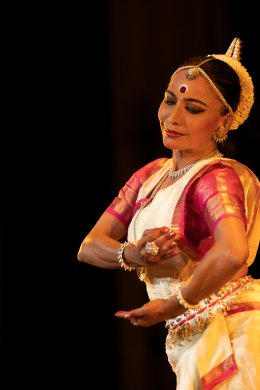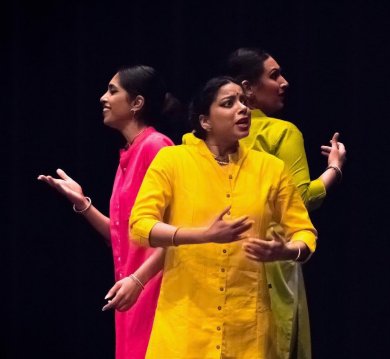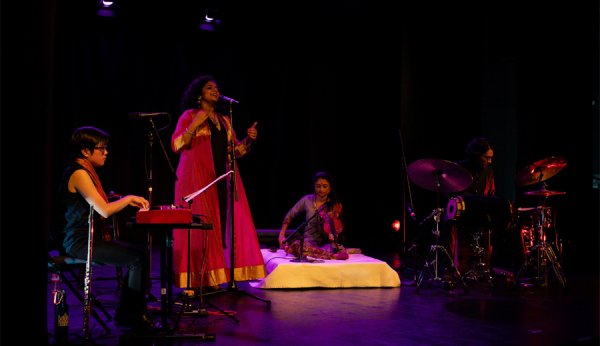
|   |

|   |
|
Drive East in San Francisco - Renee Renouf Hall August 24, 2019 Drive East is the mid-late summer festival of Indian music and dance produced by Navatman, a New York based cultural institution, for the past four or five years. From August 5-11 Drive East presented its array of artists in New York and August 15-18 in San Francisco. Headlining are Indian-based artists of considerable luster. In both instances many performing are resident in the respective areas; it is clear Navatman wants engagement and recognition for these exponents, many of whom are U.S. born. In San Francisco, the festival has been co-presented as Drive East: Locally sourced by Nava Dance Theatre directed by Nadhi Thekkek, at Z Below, the small theatre space originally created for the Traveling Jewish Theatre.  Bijayani Satpathy Photo: Anubhava Bijayani Satpathy is a small, beautifully proportioned, exquisite-faced woman with eyes proclaiming woman's mysteries at their most beguiling, and the allure arising from shifting moods and transient emotions. Her hands are supple, her fingers eloquent accents and her arms constant reminders as facilitators to feeling. I cannot fathom any man in his right mind being able to resist her. Her portrayals, with all the transient expressions rising in her eyes, underlined by a facial muscle or two, her mouth completing the emotion, were utterly free of guile, thanks to her subject matter, save, of course for an impressive portrayal of Ravana, the demon who abducted Sita to Sri Lanka. Satpathy's dance style is Odissi, the classical form from Orissa, where the medieval Hindu temples are copiously adorned with dancers in the tribhanga, or three angled-position, constituting Odissi's basic classical stance just as Bharatanatyam is noted for the triangle, Kathakali the square and Kathak the vertical, a penetrating analysis made by Dr. Kapila Vatsyayan. A former member and teacher at Nrityagram, the recorded music is credited as its source. Her four number program had for choreographers, Surupa Sen for Srimati and Sakhi He and the late, great Guru Kelucharan Mohapatra for the opening Mangalacharan and the final, masterful Sita Haran. Let me refer to Marina Harss' review for details of Satpathy's dramatic gifts. For me her dramatic range solidified itself between Sakhi He and Sita Haran with the contrasts between the bewitched, compliant feminine and the slimy, savage, rapacious Ravana, wild-eyed, unhinged, demonic. When Dr. Kapila Vatsyayan lectured at U.C., Santa Cruz, she emphasized that the popularity of the Gita Govinda was based on Krishna's human incarnation, providing the devotee with a deity to whom Hindus could relate and converse, giving rise to the Hindu bhakti or devotional movement, of which the Gita Govinda is the supreme example. Sakthi He embraces the convention of the nayika or heroine, confiding in her sakhi of her experience with Lord Krishna and their mutual passion, asking the sakhi to bring them together once again. Satpathy's portrait exposes the most intimate expressions, my reaction one of feeling I was spying on two passionate individuals. From such a sense of exclusive exposure, Kelucharan's Sita Haran steps into narrative of good, evil. the cause and effect of naive and innocent desire, setting in motion the enormous struggle involving Rama and Ravana, no less interesting but clearly more objective in subject matter and treatment. Sita Haran explores the Golden Deer episode of the Ramayana, the object desired of Sita, her plea to Rama and his soldiering his bow, the false cry to Lakshman, Lakshman's initial refusal to respond and the utter misery when Sita breaches the magic lines drawn by Lakshman, plus the magnificent bird's death throes after his attempt to rescue Sita. As Johanna Friedmann and I waited between Satpathy and Hidayat Khan, Paul Parrish remarked with distinct awe on the measured beats of Sita's despair when she realized she had been deceived. I added how taken I had been with the convulsive death gasps of that fated bird. I wish I was more cognizant of the Hindustani musical tradition beyond its format and the practical conventions of the tuning of both instruments, sitar and the two drums constituting the tabla. I am generally familiar with the Hindustani musical history assisted by Wikipedia, but I don't pretend to musical expertise in its practice or theory. India-based Hidayat Khan, the 7th generation sitar exponent, is a singularly handsome-faced man with chiseled features, whom I passed smoking en route to Z Below; Enayet Hossain appears to have settled in Maryland, working on Hindustani musical texts as well as collaborating cross-culturally musically. It might be noted that Maryland was Chitresh Das' introduction to the United States. The tuning of the instruments took several minutes, Hidayat applying a wooden tool to adjust the pegs; Hossain required more vigorous adjustments to his tabla than I have been accustomed to. The selection, announced by Khan, and starting with the letter J, was one he attributed to his father, Ustad Allaudin Khan, and Hidayat provided a number of references which were difficult to catch. But as partial testimony to his father's compositional skills, Allaudin Khan was responsible for the music of Satyajit Ray's Jalsagar. The raga itself lasted an hour and was warmly received. One negative note regarding the program itself, printed on slick black paper, with the daily performance printed on a white insert. While it provides basic information on the artists appearing, both East and West Coast based, in addition to Satpathy and Khan, the color does not lend itself to easy reference, and it led me to speculate whether its use was due to a special discount on disused stock. I hope the 2020 festival corrects the color; it was hard deciphering on senior citizen-aged eyes. After the surpassing experience of Satpathy and Khan on Aug 15th evening, what would Drive East's 2019 second program in San Francisco provide? The two offerings did not pretend to classical format, if schooled in solid classical foundations.  Unfiltered Photo: Pratibimb Sahasra Sambamoorthi's character appeared domestic, purchasing food and kitchen supplies for the home. One observed her returning and storing items from her grocery bags before preparing something for someone, whether an employer or a relative or husband was unclear. Something missing from the offering; Sambamoorthi's face as she flinched from a tirade made one realize just how arbitrary this unseen creature was. So extreme, it found her locked out, turning the house key futilely, knocking on the door for entry, her foot and bells marking the desperate effort. Nadhi Thekkek came across as the most flirtatious of the three; it was not clear whether she had been invited by some long-time friend or relative to choose a dress to attend a special event. Nadhi sorted through several gowns on a rack, choosing one which pleased her enormously, although his reaction was uncertain. She also tried on what seemed to be a pair of extreme shoes, clearly feeling she was smart as paint. Nadhi seemed predestined for trouble. A party ensued, whether an event or a bar was uncertain. But she accepted one drink and became quite merry. After some equivocation, a second drink was offered, and it became clear it was a mickey. Nadhi awoke to find herself on the floor opposite where she had imbibed her mistake; she was misery personified. It did not seem she had been abducted, but she had been violated. I don't know whether it is the medium or the skill of the exponent, but abhinaya and the Indian dance tradition can together magnify and convey misery like few styles of dance, abetted, of course, by the quality of the dancer. One or two of the gestures might have been explained to us Western dullards to help heighten our appreciation of the dramatic events. At one point, their backs to the audience, the trio looked at each other and touched gently. It was a brief, archetypal gesture of support, to me more touching than the assertions which followed. The successive declarations, "I don't deserve this; It's not my fault," each coming forward, and then inter-weaving, gave the trio space to move in Bharatanatyam style with punch and energy. Rasika Kumar has been responsible for a number of choreographic innovations within the Bharatanatyam idiom. I reviewed earlier a solo performance on Courage, exploring traditional Hindu myths and epics on the women in such tales and their responses; later on Gandhi, most recently on Martin Luther King. Here, however, the three exponents schooled by three differing teachers, collaborated on the all too prevalent theme of women exploited in current society. Their music was supplied by Roopa Mahadevan who became the lead performer in the evening's second half, appearing with the percussion whiz Rohan Krishnamurthy plus two talented local artists, pianist and flautist Erica Oda and violinist Anjana Swaminathan. Mahadevan is a woman ample in spirit and body, dressed cross-culturally in a long diaphanous golden covering street-length black, generous drop earrings and a mass of curly hair which showed signs of being hennaed. After the traditional Indian tuning vocal sounds, which find a parallel in flamenco, her initial songs displayed strong Western influence though later she recited Indian solflege and syllables in the Carnatic tradition, displaying the basic understanding with which she had created the score for the previous work, Unfiltered. She gave space for Krishnamurthy's percussion solo, a blend of usual Western jazz symbols, the mridangam, the Peruvian cajon, which was mesmerizing. She acknowledged the contributions made by Erica Oda on keyboard and with the flute, and violinist Anjana Swaminathan, for their support on two days' notice. Oda's brief contribution with the flute was connected, of course, with Krishna, eliciting Indian language lyrics from Mahadevan. I would love to have heard more from Swaminathan whose piquant, heart-shaped face was enlivened throughout with inquiring eyes as she bowed her violin in its traditional South Indian position.  Roopa in Flux (Photo: Leo Resplendor) I left the performance with distinct appreciation for the skill with which these artists, all trained in some one classical idiom within the United States and with periodic exposure to masters in India, are retaining tradition but utilizing it in service to contemporary tastes and needs without apology and with discernment. This country is darned lucky to have their presence, and there are times when I wish our conventional European-bred expressions would utilize their richness. |